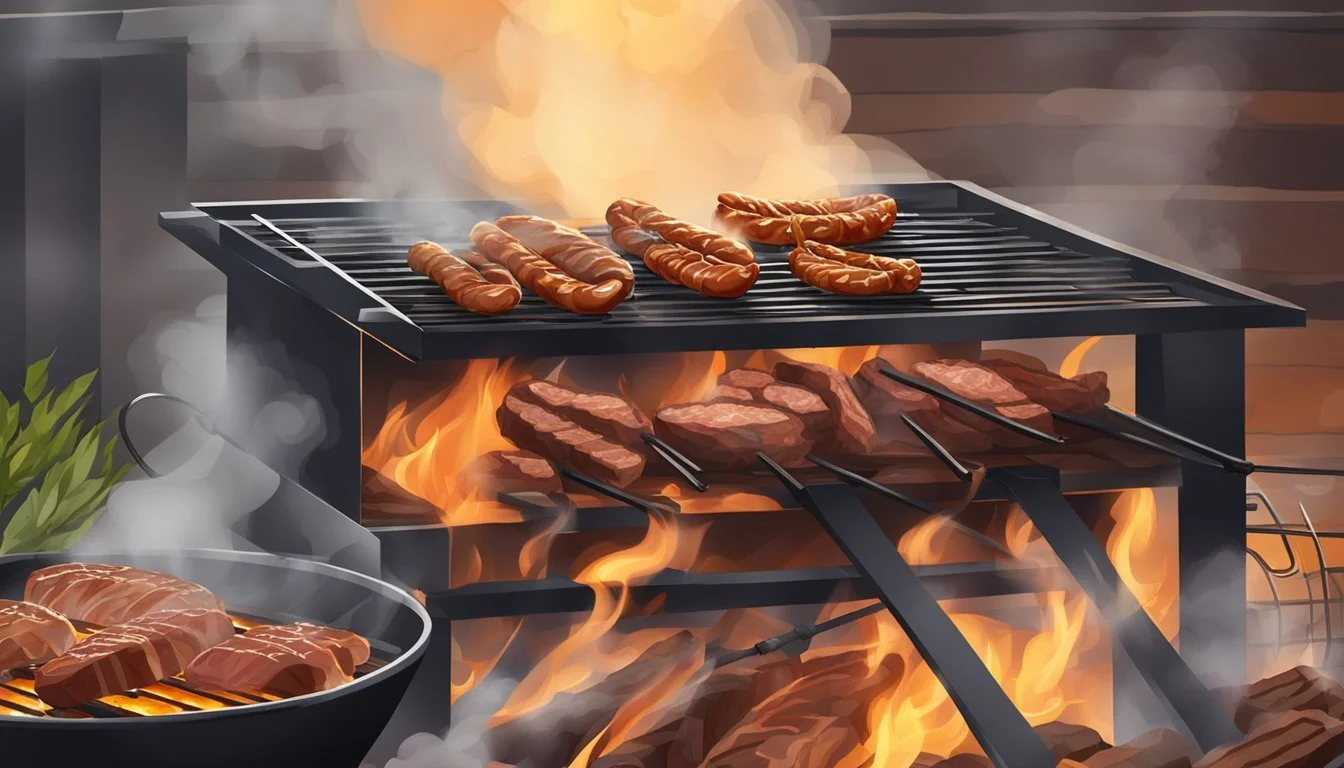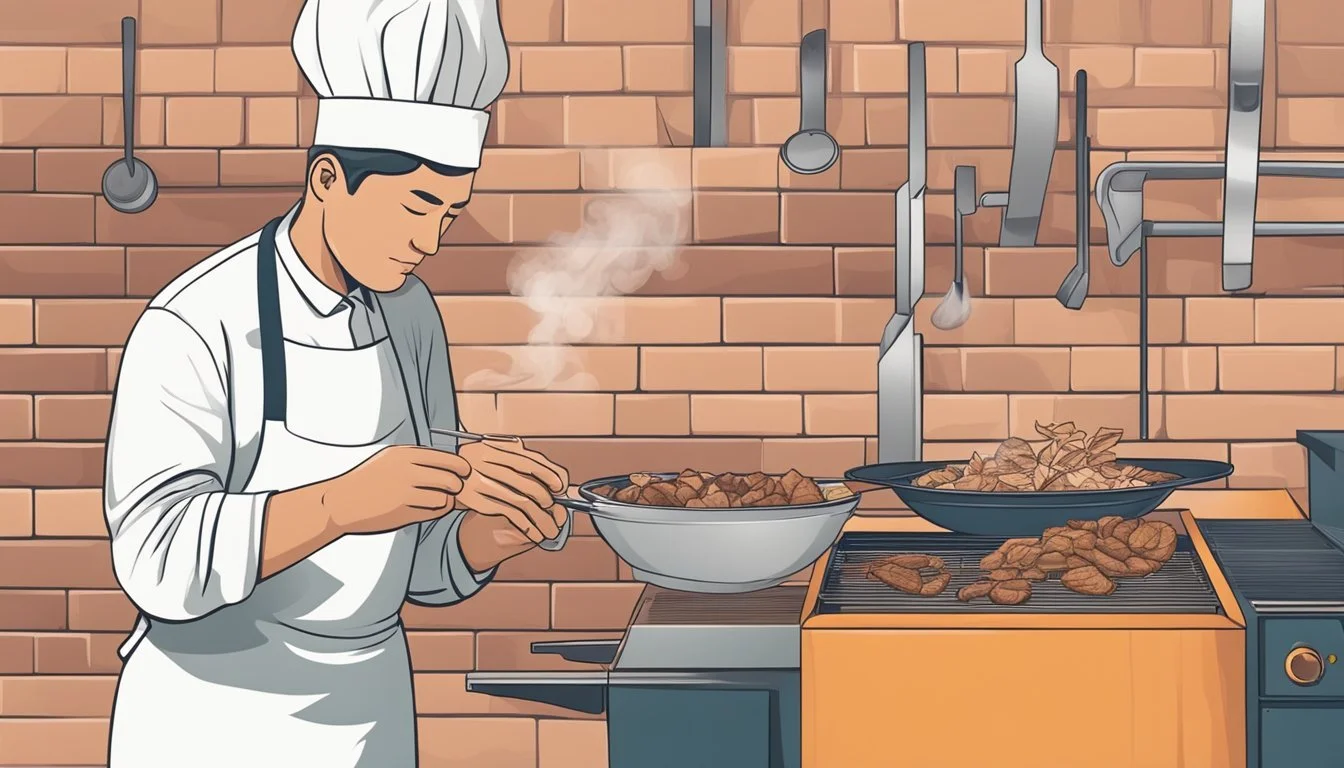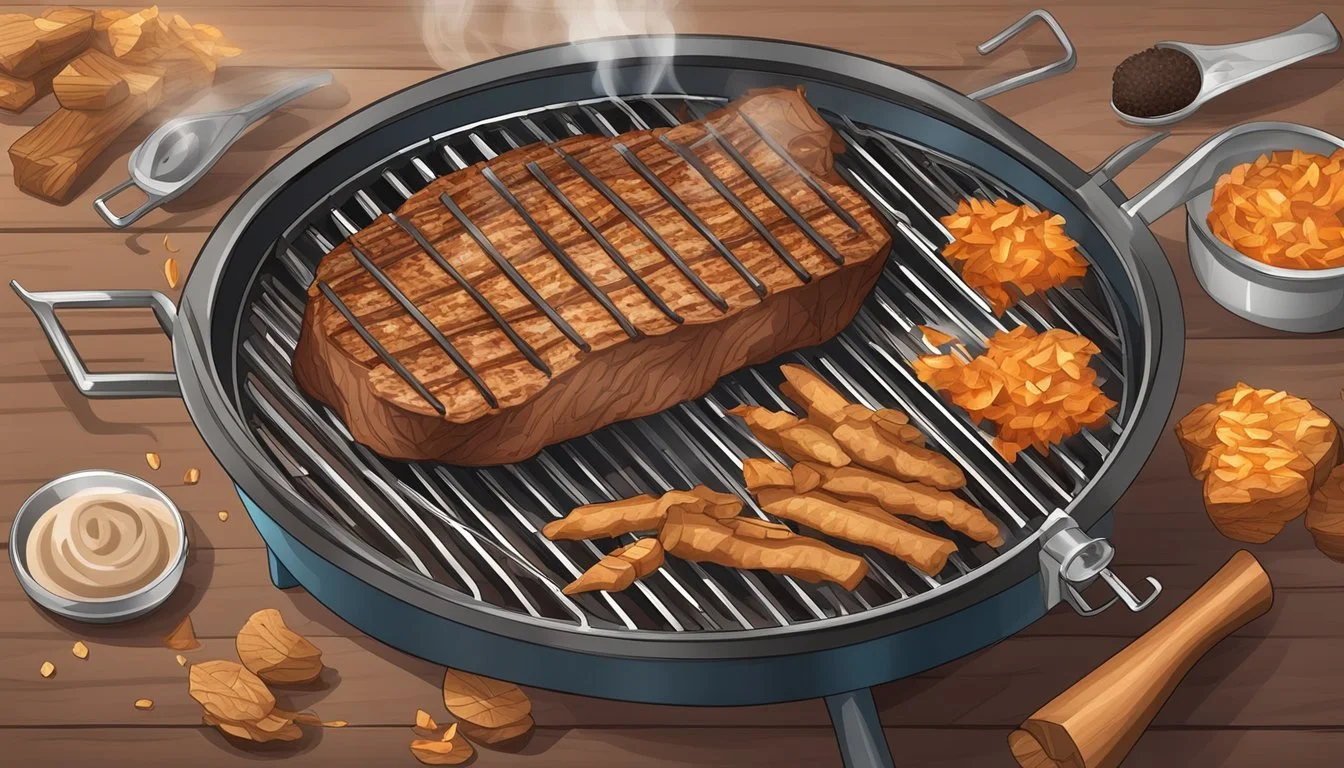Smoking Meat Essentials
Techniques for Perfect Flavor and Texture
Smoking meat is an age-old culinary technique celebrated for its ability to infuse deep flavor into food while also preserving it. This cooking process involves exposing meat to smoke from burning or smoldering materials, usually wood. The essence of wood smoke gradually permeates the meat, imparting a distinctive taste that has become synonymous with various regional cuisines around the world. Unlike grilling, smoking is performed over low heat, often within the range of 200ºF to 300ºF, over an extended period, which can last from a few hours to over half a day depending on the size and type of meat.
The practice of smoking meat straddles the line between art and science. It demands patience and an understanding of the intricate interaction between heat, smoke, and the protein structures within the meat. Each choice, from the type of wood used—popular woods for smoking include mesquite, hickory, or applewood—to the specific cuts of meat, such as brisket, pork ribs, (What wine goes well with pork ribs?) or chicken, plays a pivotal role in the character of the final dish. Smoked meats (What wine goes well with smoked meats?) are often celebrated for their tenderness and the rich layers of flavor that result from the technique's slow-cooking process.
Over time, smoking has evolved from a necessity for preservation to a method for adding complexity and depth to the flavor profile of meats. As a testament to its timeless appeal, smoking has garnered a following of enthusiasts and professionals alike who regard it not just as a means to cook but as an expressive way to elevate cooking to new gastronomic heights. The careful balance of heat and smoke, choice of seasonings, and attention to the cooking process are what make smoked meats a revered category in the world of food and cooking.
Basics of Smoking Meat
Smoking meat is a cooking technique that imparts flavor and tenderizes by exposing the meat to smoke from burning or smoldering materials, typically wood. The process requires careful heat and smoke regulation and the use of specialized equipment.
Understanding Smoking as a Cooking Method
Smoking meat is both an art and a science, relying on the controlled application of smoke to preserve and flavor the meat. Practitioners maintain a low cooking temperature, typically between 200°F to 300°F, which slowly cooks the meat, allowing it to absorb smoke and become tender. Two main methods exist: hot smoking, where the meat is both flavored by the smoke and fully cooked; and cold smoking, a technique used to impart smoke flavor without actually cooking the meat, which must be done at temperatures below 90°F.
Choosing the Right Equipment
For barbecue experts, successful meat smoking means having the proper equipment. A smoker must be capable of maintaining consistent temperatures with the use of a temperature regulator and accommodate sufficient airflow for clean combustion. It should also provide an even distribution of smoke around the meat. Thermometers are crucial for monitoring the internal temperature of the meat as well as the current temperature inside the smoker.
Types of Smokers and Fuel Sources
Different smokers and fuel sources have distinct impacts on the flavor and texture of different types of meat that you plan to smoke. To get to know what is fit for you, it's important to get familiar with the type of smoker you're going to get.
Charcoal Smokers
Charcoal grill or smokers are known for imparting a classic natural flavor packed with smokiness and are often considered budget-friendly, although they do require more attention to maintain consistent temperatures because of the meats exposure to direct heat.
Electric Smokers
Electric smokers, on the other hand, utilize electricity for heat, which simplifies temperature control but may not always deliver the traditional smoky flavor that some enthusiasts prefer.
Gas Smokers
The gas grill or propane smokers offer a similar ease of use to electric smokers, using propane as their direct heat source, and they have the added benefit of being more portable. But be weary of checking your cook time and again to keep a safe temperature.
Pellet Smokers
Pellet grills or smokers, which use wood pellets made from hardwoods, provide a consistent temperature and smoke level, thereby automating a significant portion of the smoking process. Pellet smokers is a great starting path for potential smoked meat hobbyists because of ease-of-use.
Offset Smokers
Offset smokers feature a separate firebox connected to the cooking chamber, giving users enhanced control over the smoke and indirect heat that envelops the meat - giving it strong flavor. This smoker is also known to keep the meat moist.
Different hardwoods, such as hickory, mesquite, oak, and cherry, can be used to create distinct flavors. The choice of wood, along with the selection of meat and the smoking technique, allows for a wide range of tasty outcomes.
Preparation for Smoking
The success of smoking meat hinges on meticulous preparation stages, where the choice of meat, its cut, and the seasoning play pivotal roles in defining the final flavor and texture. This emphasis on meat quality also ensures that you're getting safe meats free from harmful chemicals or potential harmful bacterial growth.
Selecting Quality Meats
When opting for raw meat to smoke, meat cooks seek out high-quality options, as they form the foundation for outstanding results. For beef, brisket is renowned for its capability to absorb smoky flavors (What wine goes well with smoky flavors?) and tenderize over long cooking periods. Pork selections commonly include rack of ribs, pork butt, and pork shoulder, known for their rich marbling and succulence post-smoking. In poultry, a whole chicken or turkey can offer a flavorful smoked outcome, whereas for fish, fattier species like salmon are desirable for their ability to stay moist through the smoking process.
Meat Cuts and Smoking Suitability
Certain cuts of meat are particularly well-suited for smoking because of their fat content and connective tissue, which can break down over time to create a tender and moist result.
For beef, brisket and ribs are the ideal cuts to smoke, as they have the right composition to enhance the smoking process. Pork ribs, butt, and shoulder are also excellent for smoking; the ribs provide a perfect combination of fat, meat, and bone for a delicious smoked flavor, while the butt and shoulder cuts are favored for their ability to absorb the smoky taste slowly, making them perfect for pulled pork dishes. Poultry, such as whole birds, is another good candidate for smoking, which can result in a flavorful and juicy meal. In the realm of seafood, fish like salmon and trout are prime choices for smoking because these oily fish respond well to the technique, developing a rich, smoky flavor.
Trimming and Seasoning
Prior to smoking, proper trimming of excess fat and silver skin from the meat assures an even and effective smoke penetration. Seasoning then comes as a crucial layer of flavor; a well-crafted dry rub often containing salt, sugar, and a blend of spices and herbs is rubbed onto the surface of the meat. Alternatively, a marinade can be used for an injection of moisture and taste, although it's more common with poultry and fish. Regardless of the seasoning method chosen, allowing the meat to rest with the seasonings prior to smoking ensures a more profound flavor profile.
Smoking Technique Mastery
Mastering the art of smoking meat requires attention to detail in three critical areas: maintaining optimal temperature, monitoring meat and smoke quality, and using wood and smoke flavors correctly. Perfecting these techniques is essential for achieving well-cooked, flavorful, and tender smoked meats.
Maintaining Optimal Temperature
To achieve success in smoking, it is essential to manage the smoker's temperature consistently. The typical range for smoking temperatures is between 200ºF and 300ºF. To ensure accuracy in maintaining these temperatures, it's crucial to use a reliable thermometer to keep track of the smoker's internal temperature and to make adjustments as needed.
Keeping the heat steady is key; this can be done by using a separate heat source to produce coals that can be added to the smoker as needed, which helps maintain consistent temperatures throughout the smoking process. Additionally, investing in a high-quality digital thermometer is advisable as it allows for precise monitoring of both the smoker's temperature and the internal temperature of the meat, ensuring that the smoking process is controlled and effective.
Monitoring Meat and Smoke Quality
The quality of the smoke and the meat's internal condition are vital indicators of how the smoking process is progressing.
Inspect the smoke: It should be thin and blueish or what seasoned pit masters call blue smoke, indicating efficient combustion of the wood that's great for the slow cooking process. Thick, white smoke can impart a bitter taste.
Internal temperature check: Always use a meat thermometer to ensure the meat reaches the desired internal temperature without overcooking.
Here's a list of meats with their respective target internal temperatures for optimal cooking:
Beef Brisket: (What wine goes well with beef brisket?)
Target Internal Temperature: 195ºF to 205ºF
Pork Shoulder:
Target Internal Temperature: 195ºF to 205ºF
Ribs:
Target Internal Temperature: 190ºF to 203ºF
Using Wood and Smoke Flavors Correctly
Different types of wood impart unique flavors and should be selected according to the meat being smoked.
Types of wood: Use woods like hickory, oak, mesquite, apple, or cherry to complement specific meats.
Soaking wood chips: Some practitioners soak wood chips before smoking, although this technique is subject to personal preference.
Avoid over-smoking: Be mindful to not over-smoke the meat, which can lead to an overpowering smoky flavor.
Here's a guide to match wood flavors with meats:
Beef: Hickory, Oak, Mesquite
Poultry: Apple, Cherry
Pork: Hickory, Apple, Cherry
Fish: Alder, Apple
By meticulously controlling temperature, assessing the smoke and meat quality, and choosing the right wood, one can master the technique of smoking meat to culinary perfection.
Post-Smoking Processes
After meat is carefully smoked, the process doesn't end with simply removing it from the smoker. There are essential steps that must be followed to ensure that the smoked meat's quality, texture, and flavor are fully realized and preserved for consumption.
Resting and Serving Smoked Meat
Allowing meat to rest after smoking is essential for a tender finish. During this period, the heat continues to distribute throughout the meat, giving collagen time to fully transform into gelatin, which contributes to the meat's moist texture. It's recommended to cover the meat with foil or butcher paper and let it rest for at least 30 minutes before serving. This practice not only enhances texture but also allows the meat to cool to a safe serving temperature.
Achieving Desired Texture and Bark
The post-smoking phase is critical for developing a robust bark, the flavorful crust on the outside of the meat. Wrapping the meat in foil can make the bark soft if left for too long, while butcher paper is more breathable, allowing the bark to firm up without drying the meat. The meat should be monitored closely to ensure that the desired texture is achieved, which will signify a properly finished product.
Safe Meat Handling and Storage
Properly storing smoked meat is key to preserving its flavor and ensuring it is safe to eat. Meat should reach an internal temperature of 145°F to 165°F before it's considered safe. Once smoked, meat can be stored in a container in the refrigerator for up to four days. For longer preservation, it can be wrapped in foil or butcher paper and frozen, keeping in mind that the quality is best when consumed within three months.
Advanced Smoking Tips
In the world of meat smoking, mastery comes not just from following recipes but also from understanding the nuances of the process. Experienced smokers know that addressing the minute details and varying techniques can significantly influence the taste and texture of their smoked meats.
Experimenting with Different Smoking Techniques
When smoking meats, variety in technique can lead to exciting new experiences. Master smokers often use a meat thermometer or an instant-read thermometer to monitor exact temperatures, avoiding overcooking or undercooking. It's essential to consider the type of fuel source — such as charcoal, wood pellets, or hardwood. Advanced techniques might include:
Cold Smoking: Imparting flavor without cooking the meat, typically at 90°F or below.
Hot Smoking: Cooking the meat through exposure to smoke in a controlled environment, generally between 200°F and 300°F.
Understanding when to use wet wood versus dry can also impact the smoke intensity and flavor.
Creating Signature Flavors and Sauces
Each smoker should aim to develop signature flavors that set their smoked meats apart. Selecting the right rub and sauce combination can elevate the natural taste of the meat:
Rub: A carefully crafted rub, applied generously before smoking, can build a complex flavor profile.
Barbecue Sauce: Applying sauce near the end of the cooking time to prevent burning and to enhance moisture.
Combining various woods and pellets can also create distinct profiles:
Hickory:
Flavor: Strong, smoky
Applewood:
Flavor: Sweet, fruity
Mesquite:
Flavor: Bold, earthy
Mixing woods during smoking can offer a unique, layered taste experience.
Avoiding Common Smoking Mistakes
To maintain a level of excellence, smokers should be aware of avoidable errors:
Temperature Control: Ensure steady temperatures throughout the process.
Fuel Management: Consistent refueling is critical for maintaining smoke levels and heat.
Meat Preparation: Allowing the meat to reach room temperature ensures even cooking.
By avoiding soaked wood, which can lead to uneven smoke and temperature problems, and by keeping a careful eye on the internal meat temperature, smokers can prevent the disappointment of poorly smoked meats. Additionally, cleaning grates and maintaining a clear airflow are crucial steps often overlooked.





